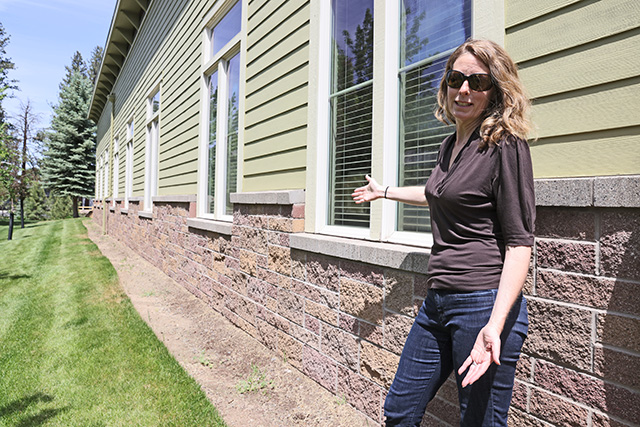How healthy?
Published 5:00 am Thursday, July 14, 2011

- Andy TullisThe Bulletin
Smoothies are generally accepted as a healthy food, but there are some nutritional questions to consider before indulging.
“There’s a wide range in what’s available in ingredients, nutritional value. They’re convenient, and hyped as health food. But they might not necessarily be healthy,” said Vandana Sheth, a registered dietitian and spokesperson for the American Dietetic Association.
Generally speaking, the fewer ingredients in a smoothie the better, she said. When ordering, ask the server what’s in the smoothie.
What’s truly healthy is fruit, milk, yogurt, maybe a little bit of juice, she said. “And that’s it.”
All ingredients should be easy to pronounce, Sheth said.
Like this: apple juice, nonfat frozen yogurt, strawberries, bananas.
That’s what’s in the popular-selling “strawberry burst,” at Blenderz, a locally-owned, drive-thru smoothie shop on the corner of Greenwood and 8th in Bend, according to owner Erik Hammer.
But McDonald’s has a longer list of more complicated ingredients in its strawberry banana smoothie: Strawberry puree, banana puree, water, sugar, concentrated apple juice, cellulose powder, natural and artificial flavors, xanthan gum, citric acid, colored with fruit and vegetable juice, pectin, ascorbic acid (a preservative), and low-fat yogurt made with cultured reduced-fat milk, sugar, whey protein concentrate, fructose, corn starch and gelatin, according to www.mcdonalds.com.
The purest ingredients don’t necessarily equate to lower calories, though. Blenderz’s 16-ounce strawberry burst has about 350 calories, Hammer estimated. McDonald’s same size strawberry-banana smoothie has 260, according to the company’s website.
A single store can offer different smoothies with huge variations in sugar, calories or fat. Calorie conscious beware: A “peanut passion” or “coconut passion” smoothie at Emerald City Smoothie in Bend can have more than 20 grams of fat (compared with its many no-fat smoothies) and hundreds of additional calories, according to www.emeraldsmoothie.com. If the store doesn’t have nutritional values listed, just ask (See “Comparing smoothies”).
Sheth said the surest way to consume a healthy smoothie is to make it yourself. No matter who is making the smoothie, a crucial thing to consider is serving size, she said.
“Serving size will determine the caloric value,” Sheth said. “Most are huge.”
Is the smoothie an entire meal? Then the ubiquitous 16- and 22-ounce smoothies, which can contain 400 calories, might be fine, so long as it has 7 grams of protein and 3 grams of fiber, Sheth said. If it’s a snack or in addition to other food, 6 to 8 ounces is ideal — about one cup — with about 150 calories, she advised. Rarely can one that small be found on a retail establishment’s menu.
When made with whole foods, smoothies can be a great way to add fruits and vegetables to one’s diet, Sheth said. Berries, bananas, melons and mangoes are just a sampling of fruits that are rich in antioxidants, vitamins and fiber. Low-fat milk can add a healthy dose of calcium. Yogurt is a great dairy addition because it offers probiotics, she said.
For one’s health, it’s important to avoid the unnecessary calories from added sugar and sweetened fruit syrups, she said. A little fruit can sweeten a drink.
Artificial ingredients, such as artificial sweeteners, should be avoided. Some have a laxative affect for some people, Sheth said. As a spokesperson for the American Dietetic Association, she was not able to endorse or disparage any specific brands or manufacturers, she added.
Mother’s Juice Cafe in west Bend sells a lot of smoothies made with basic ingredients.
Cody Periman, a store supervisor, said the 24-ounce “Sambazon” is a big seller. It’s made with organic acai berries, peaches, bananas, vanilla nonfat frozen yogurt and apple cider. But Periman doesn’t know the nutritional facts for the blended drink because the measurements are imprecise — big scoop of this, small scoop of that.
The store, like many smoothie specialty shops, offers add-ins such as wheat grass or protein powders. Many add vitamin C or echinacea herb boosts. Sheth said the boosts tend to be over-hyped products that most people don’t need. For someone making a smoothie at home, a natural boost could come from a couple of tablespoons of flax seeds or wheat germ or nuts.
Some people prefer non-dairy, so alternatives such as soy or rice milk are available at Blenderz and Mother’s. Blenderz, Mother’s and Jamba Juice representatives all said they used no sugary fruit syrup or artificial coloring or chemicals in their drinks.
Emerald City Smoothie owner John Frazier said the store uses fresh fruit and fruit juices whenever possible in its 50 different variations of smoothies, but with some more obscure flavors, such as kiwi, it will sometimes add a flavor blend of syrup.
Jamba Juice offers a low calorie drink that’s sweetened with Splenda, said Mackenzie Lind, store supervisor at the Forum Shopping Center location in east Bend. Jamba Juice has a booklet on the counter for those who want to study ingredients and nutritional information before they order.
Store-bought, packaged pre-made smoothies, such as Naked, Stoneyfield or Odwalla brands, have to list ingredients and nutritional information on their labels.








